2007 HONDA CIVIC HYBRID page 30
[x] Cancel search: page 30Page 51 of 268
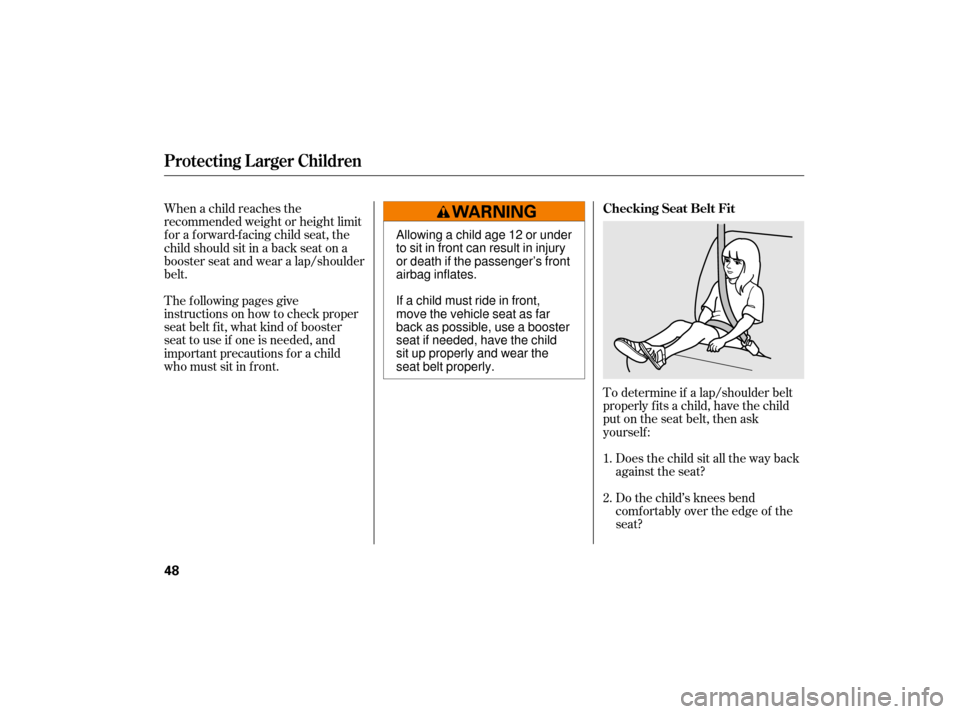
To determine if a lap/shoulder belt
properly f its a child, have the child
put on the seat belt, then ask
yourself :Does the child sit all the way back
against the seat?
Do the child’s knees bend
comf ortably over the edge of the
seat?
When a child reaches the
recommended weight or height limit
for a forward-facing child seat, the
child should sit in a back seat on a
booster seat and wear a lap/shoulder
belt.
The f ollowing pages give
instructions on how to check proper
seat belt f it, what kind of booster
seat to use if one is needed, and
important precautions f or a child
who must sit in f ront.
1.
2. Checking Seat Belt Fit
Protecting L arger Children
48
Allowing a child age 12 or under
to sit in front can result in injury
or death if the passenger’s front
airbag inflates.
If a child must ride in front,
move the vehicle seat as far
back as possible, use a booster
seat if needed, have the child
sit up properly and wear the
seat belt properly.
Page 52 of 268
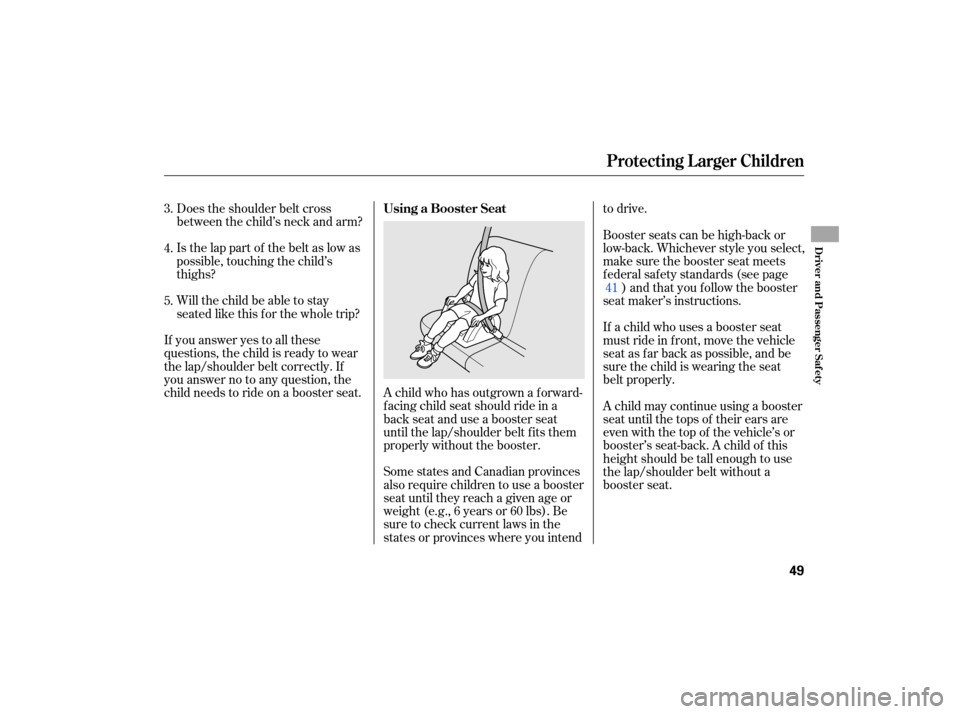
Does the shoulder belt cross
between the child’s neck and arm?
Is the lap part of the belt as low as
possible, touching the child’s
thighs?
Will the child be able to stay
seated like this for the whole trip?
If you answer yes to all these
questions, the child is ready to wear
the lap/shoulder belt correctly. If
you answer no to any question, the
child needs to ride on a booster seat. A child who has outg rown a forward-
facing child seat should ride in a
back seat and use a booster seat
until the lap/shoulder belt fits them
properly without the booster.
Some states and Canadian provinces
also require children to use a booster
seat until they reach a given age or
weight (e.g., 6 years or 60 lbs). Be
sure to check current laws in the
states or provinces where you intend to
drive.
Booster seats can be high-back or
low-back. Whichever style you select,
make sure the booster seat meets
f ederal saf ety standards (see page ) and that you f ollow the booster
seat maker’s instructions.
A child may continue using a booster
seat until the tops of their ears are
even with the top of the vehicle’s or
booster’s seat-back. A child of this
height should be tall enough to use
the lap/shoulder belt without a
booster seat. If a child who uses a booster seat
must ride in f ront, move the vehicle
seat as far back as possible, and be
sure the child is wearing the seat
belt properly.
3.
4.
5.
41
Using a Booster Seat
Protecting L arger Children
Driver and Passenger Saf ety
49
Page 53 of 268
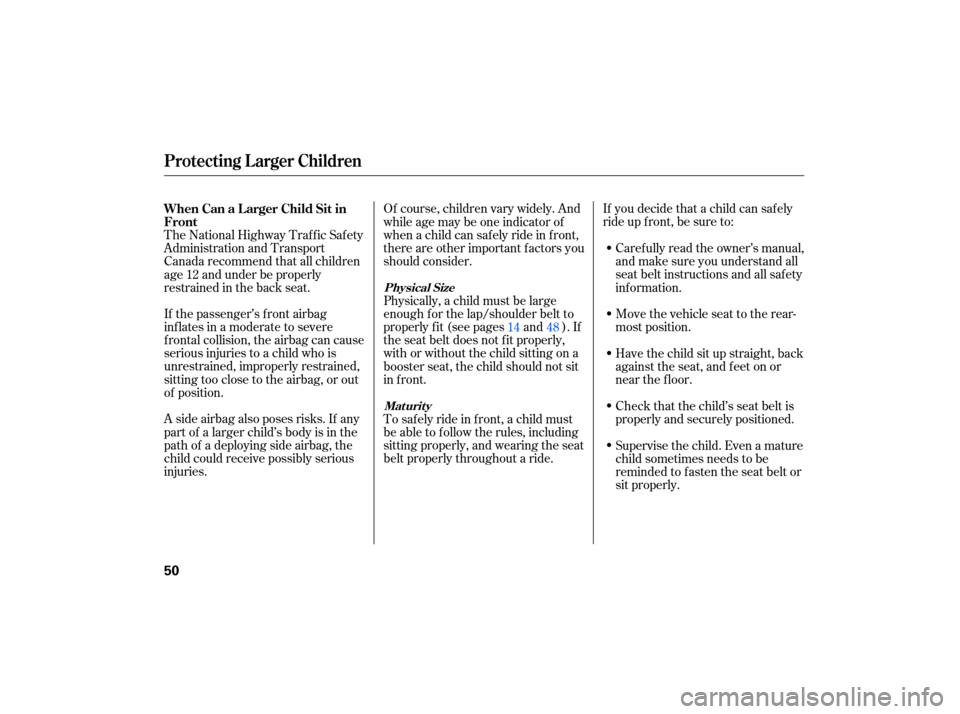
If the passenger’s front airbag
inflates in a moderate to severe
frontal collision, the airbag can cause
serious injuries to a child who is
unrestrained, improperly restrained,
sitting too close to the airbag, or out
of position.
A side airbag also poses risks. If any
part of a larger child’s body is in the
path of a deploying side airbag, the
child could receive possibly serious
injuries. Physically,
a child must be large
enough f or the lap/shoulder belt to
properly f it (see pages and ). If
the seat belt does not f it properly,
with or without the child sitting on a
booster seat, the child should not sit
in f ront.
To saf ely ride in f ront, a child must
be able to f ollow the rules, including
sitting properly, and wearing the seat
belt properly throughout a ride. If you decide that a child can saf ely
ride up f ront, be sure to:
Caref ully read the owner’s manual,
and make sure you understand all
seat belt instructions and all saf ety
inf ormation.
Move the vehicle seat to the rear-
most position.
Have the child sit up straight, back
against the seat, and feet on or
near the f loor.
Check that the child’s seat belt is
properly and securely positioned.
Of course, children vary widely. And
while age may be one indicator of
when a child can saf ely ride in f ront,
there are other important f actors you
should consider.
The National Highway Traffic Safety
Administration and Transport
Canada recommend that all children
age 12 and under be properly
restrained in the back seat.
Supervise the child. Even a mature
child sometimes needs to be
reminded to f asten the seat belt or
sit properly.
14 48
When Can a L arger Child Sit in
Front
Physical Size
Maturity
Protecting L arger Children
50
Page 55 of 268
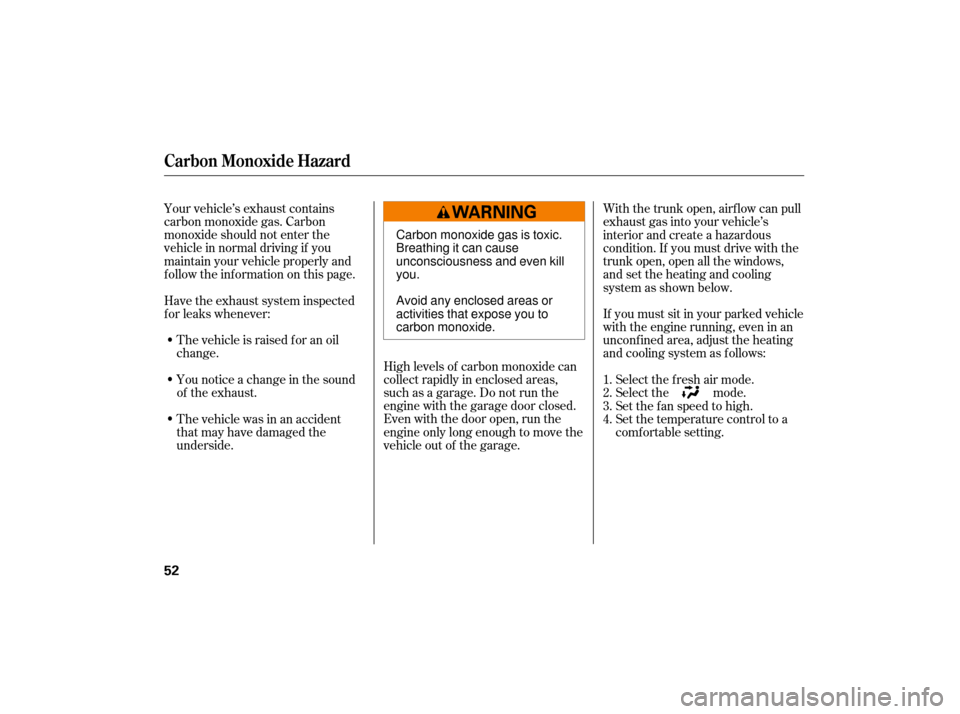
Your vehicle’s exhaust contains
carbon monoxide gas. Carbon
monoxide should not enter the
vehicle in normal driving if you
maintain your vehicle properly and
f ollow the inf ormation on this page.High levels of carbon monoxide can
collect rapidly in enclosed areas,
such as a garage. Do not run the
engine with the garage door closed.
Even with the door open, run the
engine only long enough to move the
vehicle out of the garage.If you must sit in your parked vehicle
with the engine running, even in an
unconf ined area, adjust the heating
and cooling system as f ollows:
The vehicle is raised f or an oil
change.
Have the exhaust system inspected
f or leaks whenever:
You notice a change in the sound
of the exhaust.
The vehicle was in an accident
that may have damaged the
underside. With the trunk open, airf low can pull
exhaust gas into your vehicle’s
interior and create a hazardous
condition. If you must drive with the
trunk open, open all the windows,
and set the heating and cooling
system as shown below.
Select the f resh air mode.
Select the mode.
Set the f an speed to high.
Set the temperature control to a
comfortable setting.
1.
2.
3.
4.
Carbon Monoxide Hazard
52
Carbon monoxide gas is toxic.
Breathing it can cause
unconsciousness and even kill
you.
Avoid any enclosed areas or
activities that expose you to
carbon monoxide.
Page 61 of 268
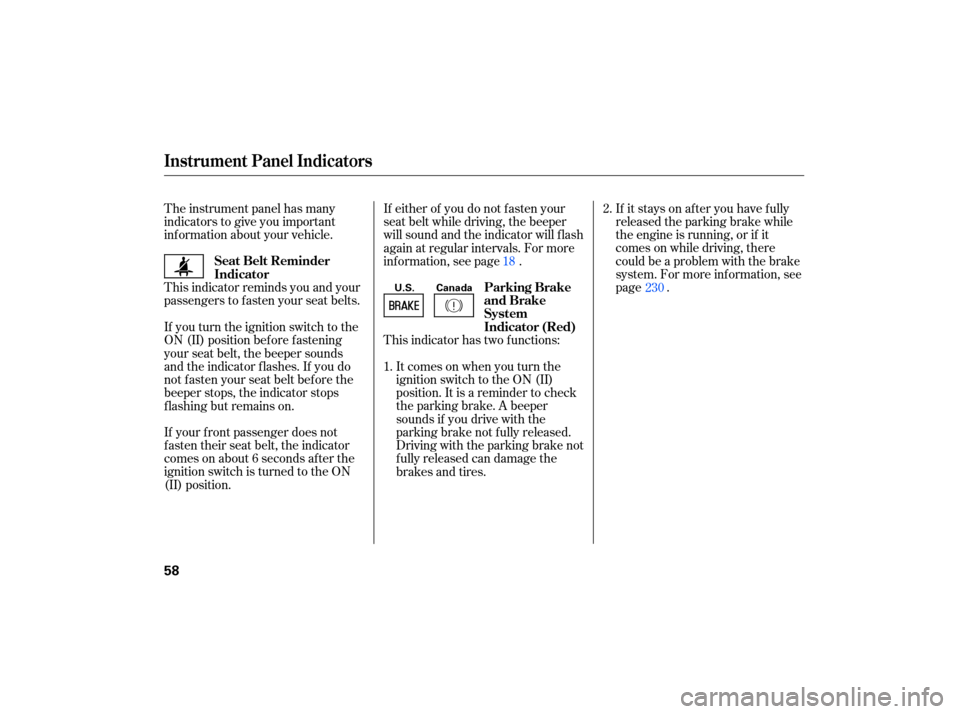
The instrument panel has many
indicators to give you important
info rmation about your vehicl e. If
it stays on after you have fully
released the parking brake while
the engine is running, or if it
comes on while driving, there
could be a problem with the brake
system. For more information, see
page .
This indicator reminds you and your
passengers to fasten your seat belts.
If your front passenger does not
fasten their seat belt, the indicator
comes on about 6 seconds after the
ignition switch is turned to the ON
(II) position. If
either of you do not fasten your
seat belt while driving, the beeper
will sound and the indicator will flash
again at regular intervals. For more
inf ormation, see page .
This indicator has two f unctions:
Itcomesonwhenyouturnthe
ignition switch to the ON (II)
position. It is a reminder to check
the parking brake. A beeper
sounds if you drive with the
parking brake not f ully released.
Driving with the parking brake not
fully released can damage the
brakes and tires.
If you turn the ignition switch to the
ON (II) position bef ore f astening
your seat belt, the beeper sounds
and the indicator f lashes. If you do
notfastenyourseatbeltbeforethe
beeper stops, the indicator stops
f lashing but remains on.
1.2.
230
18
Instrument Panel Indicators
Seat Belt Reminder
Indicator
Parking Brake
and Brake
System
Indicator (Red)
58
U.S. Canada
Page 62 of 268

This indicator normally comes on for
a few seconds when you turn the
ignition switch to the ON (II)
position. If it comes on at any other
time, there is a problem with the
ABS. If this happens, have your
vehicle checked at a dealer. With
this indicator on, your vehicle still
has normal braking ability but no
anti-lock function. For more
info rmation, see page .
This
indicator comes on for several
seconds when you turn the ignition
switch to the ON (II) position. If it
comes on at any other time, it
indicates a poten tial problem with
your front airbags. This indicator will
also alert you to a potential problem
with your side airbags, passenger’s
side airbag automa tic cutoff system,
side curtain airbags, automatic seat
belt tensioners, driver’s seat position
sensor, or the front passenger’s
weight sensors. For more
info rmation, see page . This
indicator comes on for several
seconds when you turn the ignition
switch to the ON (II) position. If it
comes on at any other time, it
indicates that the passenger’s side
airbag has automatically shut off.
For more information, see page .This
indicator comes on briefly when
you turn the ignition switch to the
ON (II) position. It will then go off if
you have inserted a properly-coded
ignition key. If it is not a properly-
coded key, the indicator will blink,
and the engine’s fuel system will be
disabled (see page ).
30 78
174
30
Supplemental Restraint
System Indicator
Immobilizer System
Indicator
Anti-lock Brake System
(A BS) Indicator Side Airbag Of f
Indicator
Instrument Panel Indicators
Inst rument s and Cont rols
59
U.S. Canada
Page 63 of 268
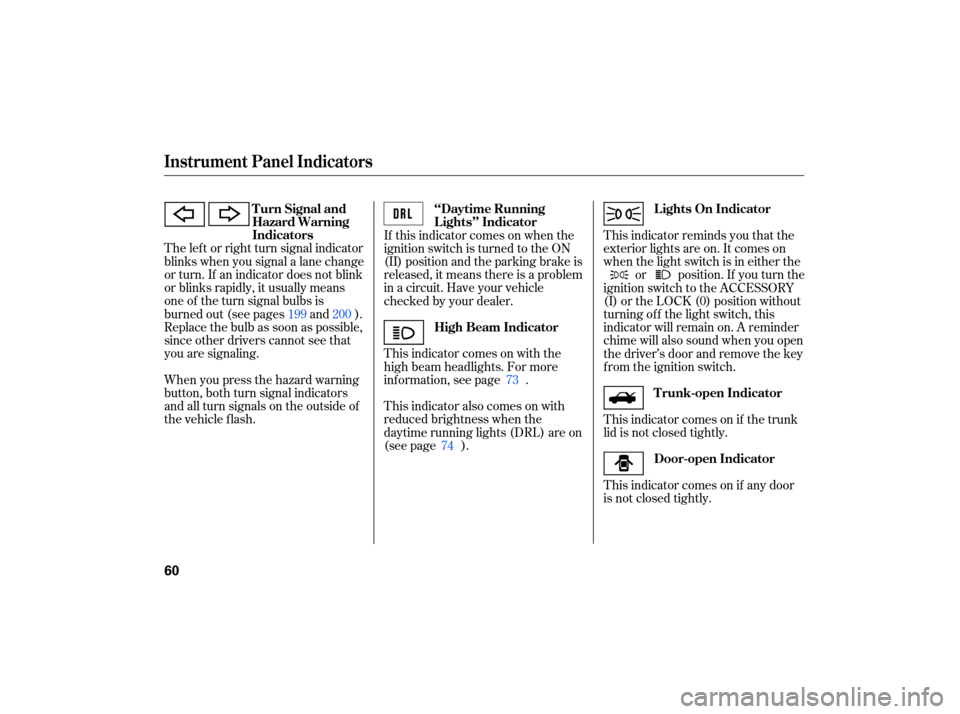
The left or right turn signal indicator
blinks when you signal a lane change
or turn. If an indicator does not blink
or blinks rapidly, it usually means
one of the turn signal bulbs is
burned out (see pages and ).
Replace the bulb as soon as possible,
since other drivers cannot see that
you are signaling.
When you press the hazard warning
button, both turn signal indicators
and all turn signals on the outside of
the vehicle flash. If
this indicator comes on when the
ignition switch is turned to the ON
(II) position and the parking brake is
released, it means there is a problem
in a circuit. Have your vehicle
checked by your dealer.
This indicator comes on with the
high beam headlights. For more
info rmation, see page .
This indicator also comes on with
reduced brightness when the
daytime running lights (DRL) are on
(see page ). This indicator reminds you that the
exterior lights are on. It comes on
when the light switch is in either the
or position. If you turn the
ignition switch to the ACCESSORY
(I) or the LOCK (0) position without
turning of f the light switch, this
indicator will remain on. A reminder
chime will also sound when you open
the driver’s door and remove the key
from the ignition switch.
This indicator comes on if the trunk
lid is not closed tightly.
This indicator comes on if any door
is not closed tightly.
199 200
73
74
Instrument Panel Indicators
Turn Signal and
Hazard Warning
Indicators Lights On Indicator
‘‘Daytime Running
Lights’’ Indicator
High Beam Indicator
Trunk-open Indicator
Door-open Indicator
60
Page 64 of 268

This indicator comes on when you
turn on the cruise control system by
pressing the CRUISE button (see
page ).
This indicator comes on when you
set the cruise control. See page
for information on operating the
cruise control.
This indicator comes on when the
washer fluid level is low. Add washer
fluidwhenyouseethisindicator
come on (see page ). This
indicator reminds you that it is
time to take your vehicle in for
scheduled maintenance. The
maintenance main items and sub
items will be displayed in the
inf ormation display. See page f or
more inf ormation on the
maintenance minder.
This indicator goes of f when your
dealer resets it after completing the
required maintenance service.
This indicator is in the f uel gauge. It
comesonasareminderthatyou
must ref uel soon. When the indicator
comes on, there is about 0.9 US gal
(3.5
) of f uel remaining in the tank
bef ore the reading reaches E. There
is a small reserve of f uel remaining
in the tank when the reading does
reach E.
145 145
194 179
Canadian models only
Instrument Panel Indicators
Cruise Main Indicator
Maintenance Minder
Indicator
Cruise Control Indicator
Washer Level Indicator Low Fuel Indicator
Inst rument s and Cont rols
61